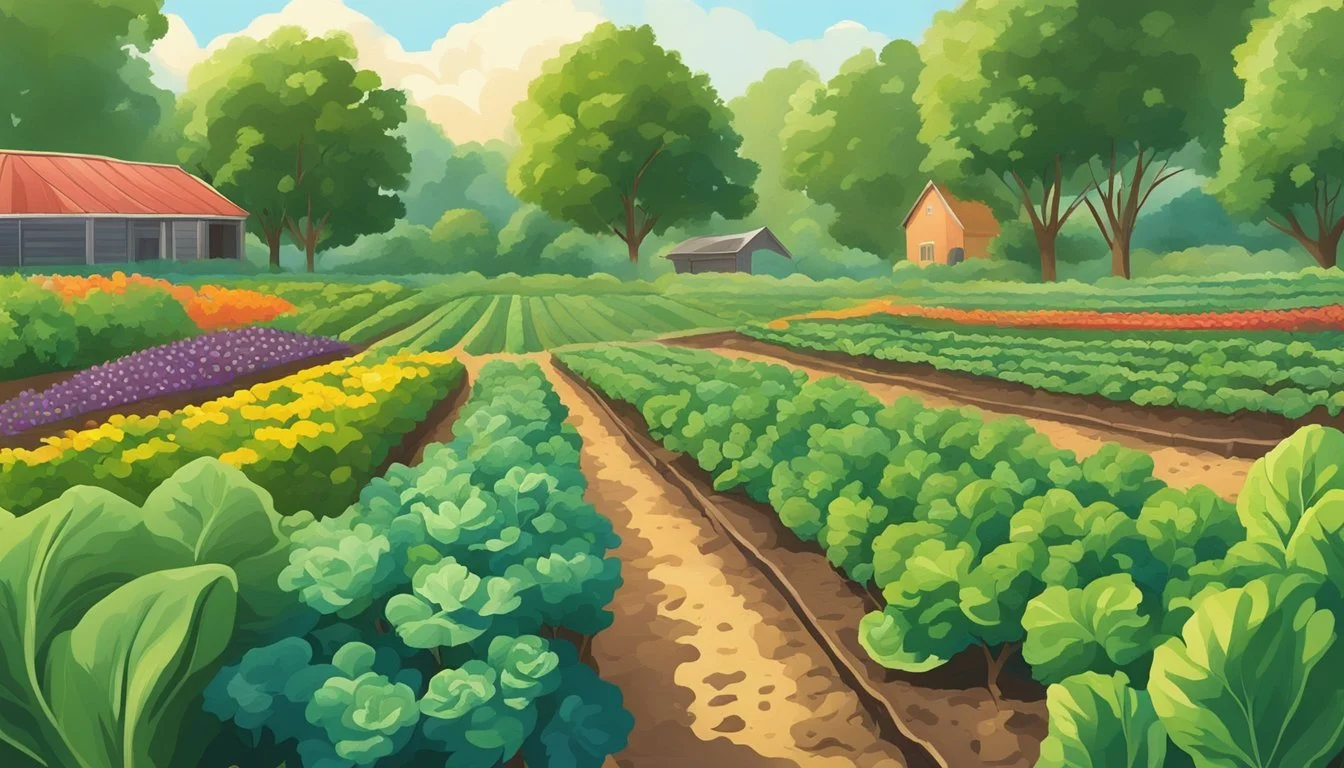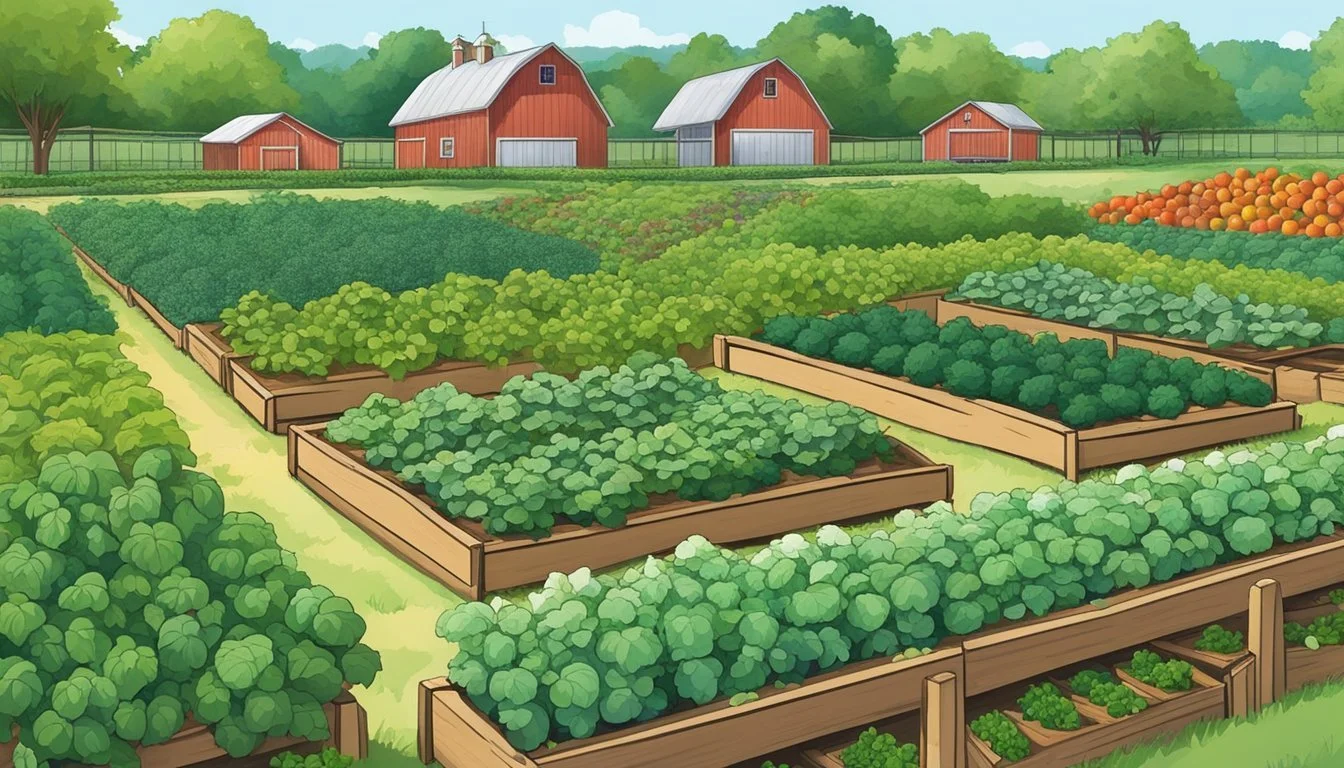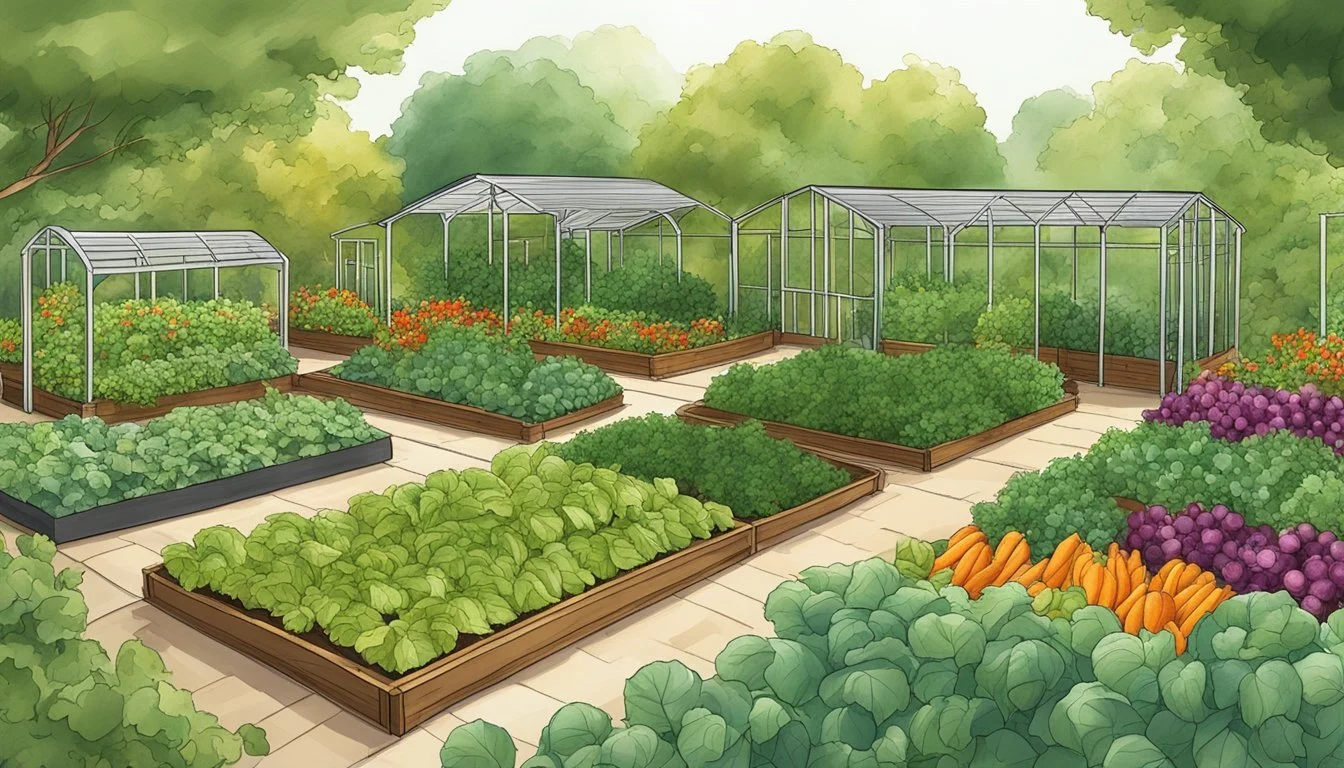Vegetable Gardening in Arkansas
A Guide to Thriving Gardens
This Article is Part of Our Guide on Vegetable Gardening by State
Vegetable gardening in Arkansas offers a rich opportunity for both amateur and experienced gardeners to cultivate a diverse array of produce thanks to the state's varied climate conditions. The region's warm temperatures and ample rainfall create an ideal environment for growing a wide range of vegetables, such as tomatoes, peppers, squash, and cucumbers. This climatic advantage enables gardeners to harvest abundant yields and possibly extend the growing season compared to other regions.
Arkansas's growing season is conducive to planting a variety of vegetables that suit the cool springs and falls, as well as the hot summers. Lettuce, for example, proves to be a robust choice for the cooler months, thriving even in the presence of frost, while heat-loving plants like tomatoes and corn relish the state's sunny, summer days. The key to a successful vegetable garden in Arkansas lies in understanding the specific needs of each plant and timing the planting season to take full advantage of natural light conditions, temperature, and moisture levels.
When planning a vegetable garden in Arkansas, it's important to consider the local soil conditions and potential challenges, such as the competition from tree roots and the shading from larger plants which can impact growth. Gardeners should be equipped with the knowledge of when to plant specific vegetables and how to manage resources, including soil health and water availability, to ensure a thriving garden throughout the growing season. By doing so, Arkansas gardeners can effectively harness the region's natural benefits to produce a vibrant and nourishing vegetable garden.
Understanding the Arkansas Climate
The Arkansas climate is vital for gardeners to consider when planning their vegetable gardens. Understanding temperature patterns, frost dates, and the best planting times can help ensure a successful harvest.
Climate Characteristics
Arkansas features a humid subtropical climate which includes hot summers and mild winters. Gardeners must be mindful of the hot and humid conditions prevalent from June through September when temperatures can soar above 90°F.
Hardiness Zone and Frost Dates
The state falls into the USDA Hardiness Zones 6 through 8. These zones are crucial for determining plant viability, with last frost dates typically occurring in early April and first frost dates near the end of October.
Frost Dates for Arkansas
Last Frost: Early April
First Frost: Late October
Optimal Planting Dates
Planting dates vary by vegetable, but a general rule in Arkansas is to start spring planting after the danger of the last frost has passed. More resilient crops can handle the cooler early part of Spring, while sensitive plants should be sown after this period. Autumn planting should be calculated backward from the first frost, allowing plants to mature before winter chilling.
Soil Preparation
Effective soil preparation is the cornerstone of a successful vegetable garden in Arkansas. The process involves amending the soil, understanding the soil types, adjusting pH levels, and utilizing practices like composting and crop rotation to enhance soil fertility and structure.
Amending the Soil
To amend the soil means to improve its physical properties. Gardeners in Arkansas should focus on providing their plants with well-draining, nutrient-rich soil. This often requires the addition of organic matter, such as compost, to improve soil structure and nutrient content. An application of a balanced, soluble fertilizer, like a 10-20-10 mix, further enriches the soil.
Soil Types and pH Levels
Arkansas gardens may encounter a variety of soil types including sandy soil, which drains rapidly but loses moisture and nutrients quickly, and clay soil, which retains moisture but may not allow adequate air to reach plant roots. It is crucial to identify the soil type and adjust the pH level accordingly. Most vegetables thrive in slightly acidic soil with a pH between 6.0 and 7.0. Soil testing kits are available to determine the current pH level, and amendments such as lime or sulfur can adjust the pH as needed.
Composting and Crop Rotation
Composting is the process of decomposing organic matter to produce a nutrient-rich soil amendment. Regular addition of compost can build up soil quality over time, which is particularly useful in improving sandy soils. Crop rotation is another important practice, involving alternating the types of crops grown in a particular area from season to season. This method prevents the depletion of specific nutrients, reduces soil erosion, and can break the cycle of soil-borne diseases and pests.
Vegetable Selection
Selecting the right vegetables for Arkansas gardens involves a keen understanding of the local climate and seasonality. Gardeners must consider the varied temperature ranges and the adequate sunlight each vegetable type requires to thrive.
Choosing Vegetables for Arkansas
When considering vegetables for an Arkansas garden, one must look for those suited to a humid subtropical climate. Successful crops often include:
Leafy greens: Lettuce, spinach (What wine goes well with spinach?), and kale, which prefer cooler seasons.
Root vegetables: Carrots, radishes, and beets, known for their frost tolerance.
Fruit-bearing plants: Tomatoes, peppers, cucumbers, and eggplant (What wine goes well with eggplant?), which need full sunlight.
Legumes: Beans and peas, which are generally flexible with the climate.
Starchy crops: Corn and potatoes, requiring a consistent warm period to mature.
Seasonal Vegetable Planning
Planning a vegetable garden in Arkansas entails understanding two primary growing seasons:
Cool-season crops (Spring/Fall): These include lettuce, spinach, peas, onions, and carrots. They can often withstand light frosts.
Vegetable Planting Time Harvest Time Lettuce Early spring Late spring Spinach Early spring Late spring
Warm-season crops (Summer): Such as tomatoes, sweet corn, green beans, and squash, these crops prefer extended daylight and warmer temperatures.
Vegetable Planting Time Harvest Time Tomatoes After last frost Mid-summer
Companion Planting and Crop Diversity
Employing companion planting enhances the garden's biodiversity and can lead to healthier vegetables. For instance:
Tomatoes grow well with basil, which is said to repel pests.
Carrots are beneficial near tomatoes, as they can loosen the soil.
Beans fix nitrogen in the soil, assisting neighboring crops like corn.
Including a mix of the plants mentioned enriches the soil and can improve overall growth and yields. Selecting a diverse array of vegetables suited to Arkansas's growing conditions is key to a bountiful and healthy garden.
Vegetable Gardening Techniques
Successful vegetable gardening in Arkansas involves understanding the best practices for planting and maintenance, specifically regarding transplanting, direct sowing, and efficient space utilization within the garden.
Transplanting and Direct Sowing
Gardeners in Arkansas often start with transplanting or direct sowing methods. Transplants should be given a strong start by ensuring that they are hardened off properly before being introduced into the garden. This gradual acclimation reduces transplant shock. Direct sowing, on the other hand, involves planting seeds directly into the garden soil. Vegetables such as carrots and radishes thrive when seeds are sown directly because they do not transplant well.
Transplanting Steps:
Harden off transplants to prepare for outdoor conditions.
Dig holes twice the size of the root ball.
Space appropriately according to plant requirements.
Direct Sowing Steps:
Prepare the soil by tilling and adding organic matter.
Plant seeds at the correct depth, following packet instructions.
Water gently to ensure even soil moisture without disturbing the seeds.
Maintenance and Care
Maintenance is key to a thriving vegetable garden, requiring consistent care for optimal growth. Gardeners should monitor sunlight, ensuring that most vegetables receive full sunlight while leafy vegetables, such as lettuce and spinach, can tolerate more shade. Regular watering, weeding, and pest control are also critical for maintaining the garden's health.
Ensure 6-8 hours of sunlight for full-sun crops.
Water plants deeply at the base to encourage root growth.
Apply mulch to retain soil moisture and control weeds.
Vertical Gardening for Space Efficiency
Vertical gardening is a space-saving technique that uses trellises, stakes, and other structures to encourage plants to grow upwards. It is ideal for crops like tomatoes, peas, and cucumbers, which can easily be trained to climb. Vertical gardening not only maximizes space but also helps prevent diseases by improving air circulation around the plants.
Vertical Gardening Tips:
Install trellises or cages early before the plants begin to vine.
Secure plants with soft ties that won't damage the stems.
Choose low-maintenance vegetables like beans and tomatoes for vertical setups.
By implementing these techniques, gardeners in Arkansas can improve the productivity and management of their vegetable gardens through strategic planting and careful upkeep.
Pest and Disease Management
In Arkansas, effective management of pests and diseases is vital for the health and productivity of vegetable gardens. The strategies include identifying common pests and diseases, employing preventive measures, and using an array of control methods to mitigate damage.
Common Pests and Insects
Arkansas vegetable gardens face several pests such as root-knot nematodes which debilitate plant roots, and southern blight, a soil-borne fungus that attacks at the root collar. Key insect pests include:
Aphids: These small insects can cause foliage to distort and stunt growth.
Tomato Hornworms: These caterpillars can defoliate plants rapidly if not controlled.
Disease Prevention Strategies
Preventive strategies are crucial in minimizing disease spread. Conditions such as Pythium blight, which thrives in poorly drained soils, can often be prevented by ensuring good soil drainage. Gardeners should:
Rotate crops annually to reduce pathogen buildup.
Remove plant debris to minimize fungal spore sources.
Select disease-resistant plant varieties.
Natural and Chemical Control Methods
Gardeners have several control options for managing pests and diseases in their vegetable gardens. They may opt for natural methods, like encouraging beneficial insects that prey on pests or using pheromone traps. When chemical controls are necessary, it is recommended to:
Use fungicides and insecticides as directed, targeting specific pests and diseases.
Apply chemicals in appropriate conditions to avoid off-target effects and environmental damage.
Harvesting and Storage
Proper harvesting and storage of vegetables are critical for maintaining quality and prolonging shelf life. These practices help gardeners in Arkansas maximize the yield and enjoy the fruits of their labor throughout the seasons.
Determining Vegetable Maturity
When it comes to harvesting, timing is crucial. Vegetables should be picked when they're at peak maturity for the best flavor and nutrition. Indicators of maturity vary among crops:
Tomatoes and peppers: Fully colored and slightly soft to the touch.
Root crops like carrots: Firm and reach expected size.
Leafy greens: Full and vibrant leaves prior to any yellowing.
Melons: Detach easily from the vine with a gentle twist.
Gardeners should note specific signs of readiness for each type of vegetable to ensure optimal quality.
Harvest Techniques
Each vegetable has its preferred harvesting method to reduce damage and stress on the plants:
Fruits like tomatoes: Gently twist until the fruit separates from the stem, or use shears to cut them free.
Root crops: Loosen the soil around them and pull gently to avoid bruising or breaking.
Leafy greens: Cut outer leaves, allowing the inner leaves to continue growing.
Consistently using the correct technique can enhance production and prolong the harvesting season for many crops.
Storing Vegetables for Longevity
After harvest, proper storage is essential to extend the shelf life of vegetables:
Root vegetables: Store in a cool, humid place; a root cellar is ideal.
Leafy greens: Refrigerate in a loosely closed bag with a damp paper towel.
Tomatoes: Keep at room temperature away from direct sunlight.
The key is to provide a suitable environment that balances temperature and humidity to prevent spoilage and maintain freshness.
Strategies for Success
Successful vegetable gardening in Arkansas hinges on thoughtful planning, leveraging local expertise, and engaging with the community. By focusing on these strategies, gardeners can ensure a fruitful harvest that contributes to personal wellness and the wellness of the community.
Planning and Keeping a Garden Journal
Gardeners should begin with a detailed planting schedule that accounts for Arkansas' sunshine and rainfall patterns. Cool-season vegetables like lettuce and spinach thrive when planted in early spring, while warm-season crops such as tomatoes and peppers favor the warmer temperatures later in the season. Keeping a garden journal helps track plant progress, pest issues, and successful yields, allowing for continual improvement.
Cool-Season Vegetables: Onions, Peas, Radishes
Warm-Season Crops: Beans, Eggplant, Okra
Learning from Local Resources
Information from the Division of Agriculture can equip gardeners with region-specific knowledge on crop varieties and planting techniques. Utilizing fertilizers recommended by local experts can enhance soil quality and promote healthy growth. Gardeners should consider incorporating plants like marigolds to naturally deter pests and foster a robust garden ecosystem.
Local Expertise: Division of Agriculture
Soil Enhancement: Proper use of Fertilizers
Community Engagement and Education
Gardens can become centers for community engagement and education about agriculture and nutrition, especially in aging communities where gardening contributes to overall wellness. Sharing techniques for growing crops such as figs and arranging community plots fosters a sense of connection and shared responsibility. Workshops and community days can encourage cooperative gardening and collective learning.
Community Building: Shared Garden Plots, Workshops
Nutritional Learning: Benefits of Homegrown Figs
By employing these strategies, Arkansas gardeners can effectively manage their gardens and maximize the growing season's potential, benefiting individual and community wellness.







